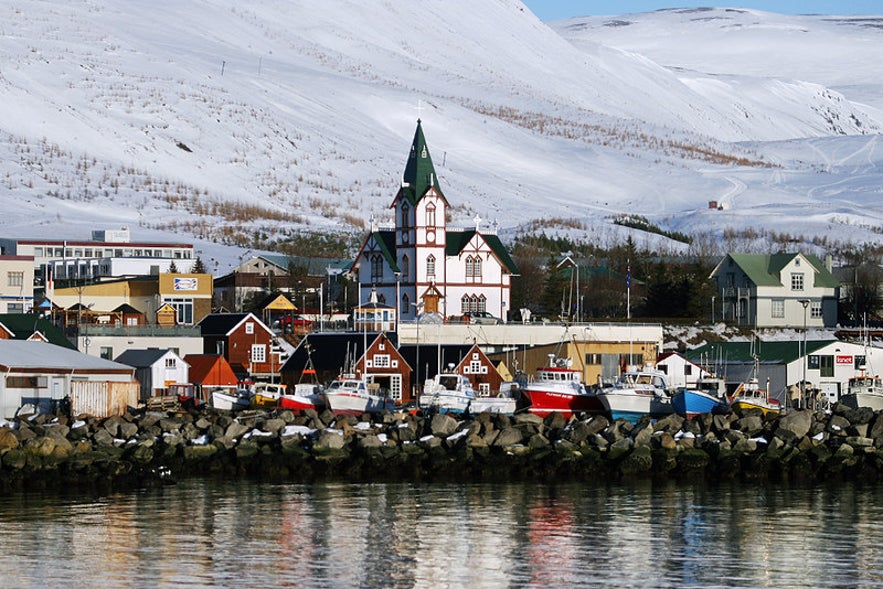
You can visit Skjalfandi bay as part of a whale-watching boat tour from Husavik, the only town on the waterfront. You can also drive along the bay's coast as part of a self-drive tour of Iceland — head north along Route 85 from the Ring Road.
Skjalfandi bay, spelled as Skjálfandi in Icelandic, is a fantastic place to see whales and other sea creatures. Several species of seabirds also live around the bay, so it's one of the best places in Iceland to see puffins during summer.
Warum du unseren Inhalten vertrauen kannst
Guide to Iceland ist die vertrauenswürdigste Reiseplattform Islands und hilft jedes Jahr Millionen von Besuchern. Alle Inhalte werden von lokalen Experten erstellt und geprüft, die Island in- und auswendig kennen. So kannst du dich auf zuverlässige, aktuelle und präzise Reisetipps verlassen.
Photo from Wikimedia, Creative Commons, by Andreas Tille. No edits made.
A Brief History of Skjalfandi Bay
Skjalfandi bay gets its name from the Icelandic word for "tremble" ("skjálfa"). The term "Skjalfandi" translates to "shaky bay" or "trembly bay." It was probably named for high levels of seismic activity in the area.
There's still the occasional tremor around Husavik and the bay, but there's been no significant earthquake here for over a century.
Skjalfandi bay is also the former home of one of Iceland's first Scandinavian settlers, Gardar Svavarsson. He arrived in Iceland around 860 and built a house in Skjalfandi — but he didn't stay long. He only spent a few months here before moving on and leaving Iceland.
Animal Life in Skjalfandi Bay
 Photo from Original 3-Hour Whale Watching Adventure in Oak Boats with Transfer from Husavik.
Photo from Original 3-Hour Whale Watching Adventure in Oak Boats with Transfer from Husavik.
Visitors to Iceland who want to see whales nearly always find themselves on a whale-watching tour in Skjalfandi bay. Humpback, blue, minke, and northern bottlenose whales swim in the waters, but there are also orcas, white-beaked dolphins, and porpoises.
The bay also contains lots of bird life. There are two islands in the bay: Flatey Island (not to be confused with the Flatey Island in the Breidafjordur fjord) and Lundey Island. Lundey Island is also known as "puffin island." It's the nesting point for Atlantic puffins, Arctic terns, guillemots, and other beautiful seabirds.
Skjalfandi Bay's Natural Beauty
 Photo from Wikimedia, Creative Commons, by Luis Bartolomé Marcos. No edits made.
Photo from Wikimedia, Creative Commons, by Luis Bartolomé Marcos. No edits made.
Skjalfandi bay is surrounded by a beautiful coastline and the Kinnarfjoll mountains, making this an incredibly picturesque destination. Glacial activity created the bay, now fed by two rivers: the Laxa and Skjalfandafljot.
The Laxa river is a freshwater river known for its large population of salmon. Parts of the river are protected from environmental damage under the Ramsar Convention.
The Skjalfandafljot river is the fourth-longest river in Iceland at 111 miles (about 180 kilometers). Its source is the Vatnajokull glacier, making it a glacial river. Springwater from the Odadahraun lava field also feeds it. The Skjalfandafljot river is where you'll find Godafoss waterfall, one of Iceland's most impressive falls.
How to Reach Skjalfandi Bay
Skjalfandi bay is situated in North Iceland, approximately 288 miles (about 463 kilometers) from Reykjavik.
The easiest way to visit the rich waters of Skjalfandi bay is on a whale-watching tour from Husavik. However, you can also take a boat tour to the bay from Akureyri, a town known as the capital of North Iceland.
Akureyri is on Route 1, so Ring Road travelers can stop off here on their way around the country. There's also an airport here with domestic flights from Reykjavik Airport.
From Akureyri, it's only 45 miles (roughly 75 kilometers) to Husavik. Follow the Ring Road east out of Akureyri for around 15 miles (about 25 kilometers), then turn left onto Route 85 (Nordausturvegur). This road leads directly into Husavik.
Other Attractions Near Skjalfandi Bay
Visitors to Skjalfandi bay can find several other sights in the nearby area.
Husavik
 Photo from Flickr, Creative Commons, by Orly Orlyson. No edits made.
Photo from Flickr, Creative Commons, by Orly Orlyson. No edits made.
The town of Husavik, right on the bay's waters, has plenty to offer tourists beyond whale-watching tours. The beautiful Husavikurkirkja church is worth a look, and the fascinating Husavik Whale Museum gives visitors a chance to learn more about the whales they've seen on the bay.
There are also horse-riding tours in the area for anyone who wants to see the coastline differently.
The Diamond Circle
Husavik is just one stop on Iceland's spectacular Diamond Circle, a 160-mile (roughly 260-kilometer) tourist route. It's North Iceland's answer to the better-known Golden Circle.
The other attractions on the Diamond Circle include Lake Myvatn, a volcanic lake with some of the best bird-watching in the country. Dettifoss waterfall, the most powerful in Europe, is also on the route, and so is the Asbyrgi canyon.
It's possible to visit all the sights of the Diamond Circle in a single day, and Husavik on Skjalfandi bay makes an excellent base.
Akureyri
There's also plenty to do in the town of Akureyri. You can see the imposing Akureyrarkirkja church or visit the Christmas House for festive fun.
Akureyri also has an interesting history and culture. Visitors can learn more about the Icelandic settlers with a visit to the Laufas turf houses. Alternatively, a trip to the botanical gardens can teach you about Arctic plant life.
Other Natural Attractions
Whether you stay in Akureyri or Husavik, there are several other natural attractions in the area that you shouldn't miss.
The Godafoss and Aedafossar waterfalls are both spectacular sights. Godafoss is only 30 miles (about 47 kilometers) from Husavik, while Aedafossar is even closer at six miles (around 10 kilometers) away.
The Hljodaklettar cliffs, known as the "echo rocks" or "whispering cliffs," are 45 miles (about 72 kilometers) from Husavik, and the beautiful Raudanes cape is just over 80 miles (a little over 130 kilometers) away.









